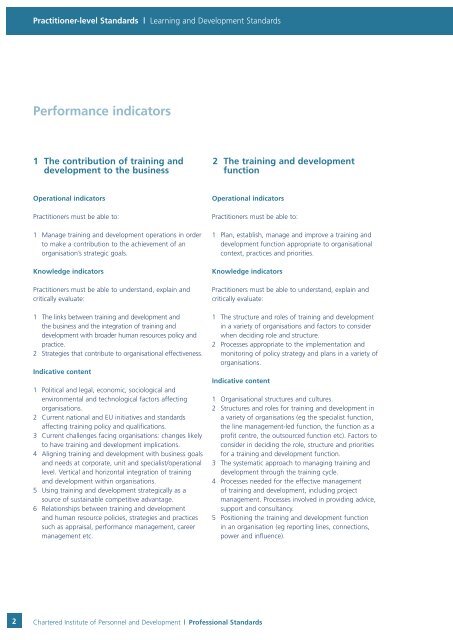Managing the Training and Development Function - CIPD
Managing the Training and Development Function - CIPD
Managing the Training and Development Function - CIPD
You also want an ePaper? Increase the reach of your titles
YUMPU automatically turns print PDFs into web optimized ePapers that Google loves.
Practitioner-level St<strong>and</strong>ards | Learning <strong>and</strong> <strong>Development</strong> St<strong>and</strong>ards<br />
Performance indicators<br />
1 The contribution of training <strong>and</strong><br />
development to <strong>the</strong> business<br />
2 The training <strong>and</strong> development<br />
function<br />
Operational indicators<br />
Practitioners must be able to:<br />
1 Manage training <strong>and</strong> development operations in order<br />
to make a contribution to <strong>the</strong> achievement of an<br />
organisation’s strategic goals.<br />
Knowledge indicators<br />
Practitioners must be able to underst<strong>and</strong>, explain <strong>and</strong><br />
critically evaluate:<br />
1 The links between training <strong>and</strong> development <strong>and</strong><br />
<strong>the</strong> business <strong>and</strong> <strong>the</strong> integration of training <strong>and</strong><br />
development with broader human resources policy <strong>and</strong><br />
practice.<br />
2 Strategies that contribute to organisational effectiveness.<br />
Indicative content<br />
1 Political <strong>and</strong> legal, economic, sociological <strong>and</strong><br />
environmental <strong>and</strong> technological factors affecting<br />
organisations.<br />
2 Current national <strong>and</strong> EU initiatives <strong>and</strong> st<strong>and</strong>ards<br />
affecting training policy <strong>and</strong> qualifications.<br />
3 Current challenges facing organisations: changes likely<br />
to have training <strong>and</strong> development implications.<br />
4 Aligning training <strong>and</strong> development with business goals<br />
<strong>and</strong> needs at corporate, unit <strong>and</strong> specialist/operational<br />
level. Vertical <strong>and</strong> horizontal integration of training<br />
<strong>and</strong> development within organisations.<br />
5 Using training <strong>and</strong> development strategically as a<br />
source of sustainable competitive advantage.<br />
6 Relationships between training <strong>and</strong> development<br />
<strong>and</strong> human resource policies, strategies <strong>and</strong> practices<br />
such as appraisal, performance management, career<br />
management etc.<br />
Operational indicators<br />
Practitioners must be able to:<br />
1 Plan, establish, manage <strong>and</strong> improve a training <strong>and</strong><br />
development function appropriate to organisational<br />
context, practices <strong>and</strong> priorities.<br />
Knowledge indicators<br />
Practitioners must be able to underst<strong>and</strong>, explain <strong>and</strong><br />
critically evaluate:<br />
1 The structure <strong>and</strong> roles of training <strong>and</strong> development<br />
in a variety of organisations <strong>and</strong> factors to consider<br />
when deciding role <strong>and</strong> structure.<br />
2 Processes appropriate to <strong>the</strong> implementation <strong>and</strong><br />
monitoring of policy strategy <strong>and</strong> plans in a variety of<br />
organisations.<br />
Indicative content<br />
1 Organisational structures <strong>and</strong> cultures.<br />
2 Structures <strong>and</strong> roles for training <strong>and</strong> development in<br />
a variety of organisations (eg <strong>the</strong> specialist function,<br />
<strong>the</strong> line management-led function, <strong>the</strong> function as a<br />
profit centre, <strong>the</strong> outsourced function etc). Factors to<br />
consider in deciding <strong>the</strong> role, structure <strong>and</strong> priorities<br />
for a training <strong>and</strong> development function.<br />
3 The systematic approach to managing training <strong>and</strong><br />
development through <strong>the</strong> training cycle.<br />
4 Processes needed for <strong>the</strong> effective management<br />
of training <strong>and</strong> development, including project<br />
management. Processes involved in providing advice,<br />
support <strong>and</strong> consultancy.<br />
5 Positioning <strong>the</strong> training <strong>and</strong> development function<br />
in an organisation (eg reporting lines, connections,<br />
power <strong>and</strong> influence).<br />
2<br />
Chartered Institute of Personnel <strong>and</strong> <strong>Development</strong> | Professional St<strong>and</strong>ards

















